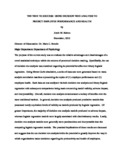The Tree to Success: Using Decision Tree Analysis to Predict Employee Performance and Health
Author
Raines, Justin M.
Abstract
The purpose of the current study was to evaluate the relative advantages and disadvantages of a novel statistical technique within the context of personnel decision-making. Specifically, the use of decision tree analysis was examined regarding its potential benefits over binary logistic regression. Using Monte Carlo simulation, a series of data sets were generated based on meta-analytic correlation matrices representing the topics of (1) employee performance and (2) employee health. Each data set was analyzed via both decision tree analysis and binary logistic regression with subsequent comparisons being made concerning model validity, adverse impact, and interpretability. Overall, decision tree analysis demonstrated a variety of benefits over the more traditional method. In general, decision tree analysis produced predictive models that possessed nearly equivalent levels of validity as models produced by logistic regression. Of greater importance, the majority of decision tree analysis models produced no adverse impact, whereas logistic regression models were largely associated with discriminatory results. Lastly, decision tree analysis models were generally more parsimonious and interpretable than the competing logistic regression models. The practical implications of these results are discussed and suggest that the use decision tree analysis holds the potential to greatly improve the way in which organizations make decisions regarding the productivity and health of employees.
Subject
Date
2015-12-10
Citation:
APA:
Raines, Justin M..
(December 2015).
The Tree to Success: Using Decision Tree Analysis to Predict Employee Performance and Health
(Doctoral Dissertation, East Carolina University). Retrieved from the Scholarship.
(http://hdl.handle.net/10342/5128.)
MLA:
Raines, Justin M..
The Tree to Success: Using Decision Tree Analysis to Predict Employee Performance and Health.
Doctoral Dissertation. East Carolina University,
December 2015. The Scholarship.
http://hdl.handle.net/10342/5128.
April 16, 2024.
Chicago:
Raines, Justin M.,
“The Tree to Success: Using Decision Tree Analysis to Predict Employee Performance and Health”
(Doctoral Dissertation., East Carolina University,
December 2015).
AMA:
Raines, Justin M..
The Tree to Success: Using Decision Tree Analysis to Predict Employee Performance and Health
[Doctoral Dissertation]. Greenville, NC: East Carolina University;
December 2015.
Collections
Publisher
East Carolina University

